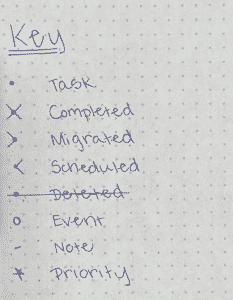bullet journal spotlight ✨ https://t.co/xngn0Ia4Uf
— bulletjournals (@bulletjournals) September 17, 2018
Until I was introduced to bullet journaling, I used to think that there was no organizational system that could possibly help me organize the messy jumble of thoughts in my head without tedious and often unsustainable effort. There are a million reasons why bullet journaling can be helpful, but personally, I think that the best part is that it is a system that allows you to rapidly organize thoughts the very moment they pop into your head. You are suddenly able to get down onto paper anything you need or want to remember, track, express, etc., the moment you think of it. This is possible because bullet journaling is a nonlinear system that involves “rapid logging” and indexing that allows you to organize the messy thoughts in your mind rapidly and with minimal effort. Bullet journaling allows for endless customization and flexibility once you understand the basics. And because bullet journaling has made such a wonderful impact on my personal and professional life, I would love to help get you started with some basics.
What You Need
Of course first things first – get a hold of a bulleted journal. Other than that all you need is something to write with. Down the road, you might choose to start using colorful gel pens, stickers, stencils, etc., to have some extra fun, but all you need to get started is a pen or pencil and a journal. I started with the original Bullet Journal that you can get here on the Bullet Journal website, but there are plenty of great alternatives for purchase at any office supply store near you or on Amazon.com. I will share links to some good options below.
Bullet Dotted Journal Kit – This one comes with stickers!🤩
A5 Dotted Journal by Scribbles That Matter – This option provides some page headings and organization direction that is great for beginners.
(3-Pack) A5 Dotted Spiral Notebook – For those who prefer spiral bound this one’s for you.
Getting Started
Once you have your journal and pen in hand, I would say that your best first step is to check out the “How to Bullet Journal” video on the official Bullet Journal Youtube channel. They have a step-by-step video to help you set up a basic version of any bullet journal. Setting up your journal is foundational to the effectiveness of your journaling and scheduling success. Take a moment to get fully acquainted with the technique you are going to adopt. Add all the necessary lines, symbols, titles, etc. before you start adding any tasks. A solid setup is going to make the entire process so much simpler and more manageable.
The Index
Alternative Bullet Journal Index: Color Coded #bulletjournal #bujo https://t.co/pnMhMFq9sU pic.twitter.com/BJsba0vV4i
— Erin💖Elissa (@erinelissa91) August 1, 2017
The index is the key to the whole ‘staying organized while bouncing around’ thing. Every time you add anything to a new page or pages, you document it in the index, making it easy to find later. Here is an image of how an index may look. It allows for you to write it ALL down (and by all, I truly mean ALL) without sacrificing any organizational flow or losing any pages. Pages tracking everyday agendas and tasks can be mixed up with pages listing your dream vacations and displaying vision boards without getting mentally or visually lost in the abyss of randomness.
Bullets For Rapid Logging

The easier it is to jot down a task, the more likely it is that you will stay consistent. The bullets themselves are a key to the rapid logging nature of bullet journaling. A commonly used and highly effective bullet system starts with a single dot bullet. Bullet journaling is most effective when used in journals with pages that have a grid format. This way, a bullet can be added within a single square, and as the task progresses or is completed, more lines can be added to the middle dot to indicate the status of the task. Above is an example of a simple bullet key.
Future Log
check out this sleek future log https://t.co/ISKbzQPL66 #futurelog #bulletjournal #bujo pic.twitter.com/QJNRBZcitd
— Jennie Rowntree (@glitteryredhead) January 12, 2021
The future log is where you can keep track of tasks or events that are scheduled for farther ahead in the future. The future log helps you keep track of things that are scheduled for the future, but may get lost if added to a daily log. It also provides a great opportunity to set up a high level overview of the coming months.
Consistent Review
An important aspect of bullet journaling is the reviewing process. Whether it is daily, weekly, or monthly, reviewing your recorded tasks is key to the success of this technique. The rapid logging allows you to quickly get everything you wish to keep track of onto paper, but the review process always you to truly mentally download all that information and have a clear overview of what has been done, and what still needs to get done.
Have Fun With It!
Habit and mood tracker ❤#bulletjournal #FelizDomingo #StudyIdeas #studygram pic.twitter.com/cLvTNEBAlP
— Nata Cardozo 🦄 (@NataCardozo4) January 14, 2019
Remember that bullet journaling is flexible, so feel free to have some fun with it and make it your own. If there is a list of places you would like to travel to one day, or you feel like writing a funny quote on an entire page, or maybe you just need to doodle, go for it! Use colorful pens, stickers, tape, collage materials, or whatever else to make it an extension of yourself. That’s what’s great, you can add virtually anything to this journal and it won’t mess up the overall organization at all. The more it becomes a living series of documentation, the more it will naturally become part of your life.
Conclusion
In a way, bullet journaling is not so different from conquering an escape room. Like an escape room, scheduling and managing daily tasks involves a series of puzzles that need to be tackled in order to escape the chaos. Bullet journaling helps you escape that “I feel like there is something I’m forgetting” feeling and gives you the freedom to plan and manage your days in a very flexible manner. It’s all about, finding your system, sticking to it, and remember to consistently review.

